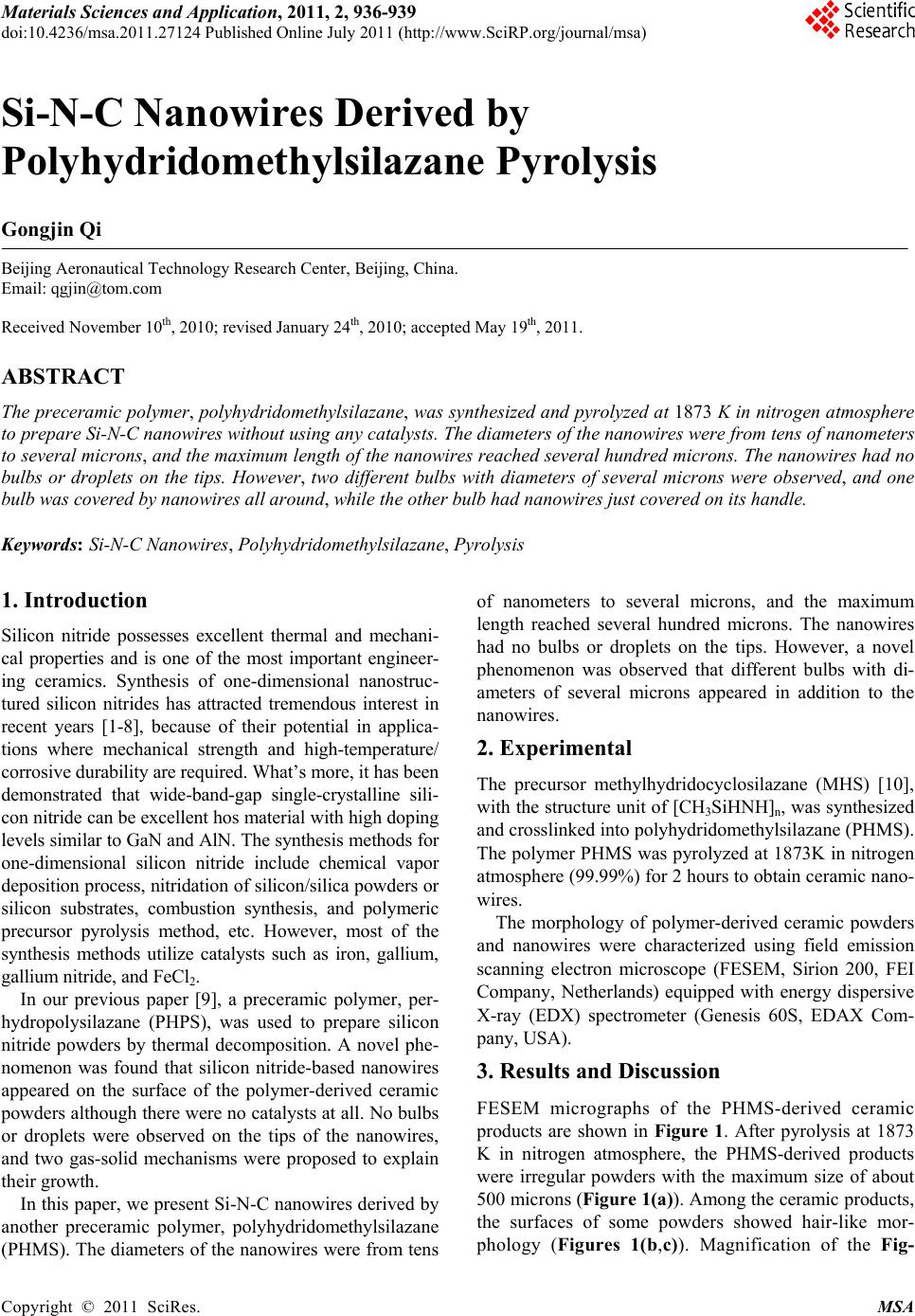
Materials Sciences and Applicatio n, 2011, 2, 936-939
doi:10.4236/msa.2011.27124 Published Online July 2011 (http://www.SciRP.org/journal/msa)
Copyright © 2011 SciRes. MSA
Si-N-C Nanowires Derived by
Polyhydridomethylsilazane Pyrolysis
Gongjin Qi
Beijing Aeronautical Technology Research Center, Beijing, China.
Email: qgjin@tom.com
Received November 10th, 2010; revised January 24th, 2010; accepted May 19th, 2011.
ABSTRACT
The preceramic polymer, polyhydridomethylsilazane, was synthesized and pyrolyzed at 1873 K in nitrogen atmosphere
to prepare Si-N-C nanowires without using any catalysts. The diameters of the nanowires were from tens of nanometers
to several microns, and the maximum length of the nanowires reached several hundred microns. The nanowires had no
bulbs or droplets on the tips. However, two different bulbs with diameters of several microns were observed, and one
bulb was covered by nanowires all around, while the other bulb had nanowires just covered on its han dle.
Keywords: Si-N-C Nanowires, Polyhydridomethylsilazane, Pyrolysis
1. Introduction
Silicon nitride possesses excellent thermal and mechani-
cal properties and is one of the most important engineer-
ing ceramics. Synthesis of one-dimensional nanostruc-
tured silicon nitrides has attracted tremendous interest in
recent years [1-8], because of their potential in applica-
tions where mechanical strength and high-temperature/
corrosive durability are required. What’s more, it has been
demonstrated that wide-band-gap single-crystalline sili-
con nitride can be excellent hos material with high doping
levels similar to GaN and AlN. The synthesis methods for
one-dimensional silicon nitride include chemical vapor
deposition process, nitridation of silicon/silica powders or
silicon substrates, combustion synthesis, and polymeric
precursor pyrolysis method, etc. However, most of the
synthesis methods utilize catalysts such as iron, gallium,
gallium nitride, and FeCl2.
In our previous paper [9], a preceramic polymer, per-
hydropolysilazane (PHPS), was used to prepare silicon
nitride powders by thermal decomposition. A novel phe-
nomenon was found that silicon nitride-based nanowires
appeared on the surface of the polymer-derived ceramic
powders although there were no catalysts at all. No bulbs
or droplets were observed on the tips of the nanowires,
and two gas-solid mechanisms were proposed to explain
their growth.
In this paper, we present Si-N-C nanowires derived by
another preceramic polymer, polyhydridomethylsilazane
(PHMS). The diameters of the nanowires were from tens
of nanometers to several microns, and the maximum
length reached several hundred microns. The nanowires
had no bulbs or droplets on the tips. However, a novel
phenomenon was observed that different bulbs with di-
ameters of several microns appeared in addition to the
nanowires.
2. Experimental
The precursor methylhydridocyclosilazane (MHS) [10],
with the structure unit of [CH3SiHNH]n, was synthesized
and crosslinked into polyhydridomethylsilazane (PHMS).
The polymer PHMS was pyrolyzed at 1873K in nitrogen
atmosphere (99.99%) for 2 hours to obtain ceramic nano-
wires.
The morphology of polymer-derived ceramic powders
and nanowires were characterized using field emission
scanning electron microscope (FESEM, Sirion 200, FEI
Company, Netherlands) equipped with energy dispersive
X-ray (EDX) spectrometer (Genesis 60S, EDAX Com-
pany, USA).
3. Results and Discussion
FESEM micrographs of the PHMS-derived ceramic
products are shown in Figure 1. After pyrolysis at 1873
K in nitrogen atmosphere, the PHMS-derived products
were irregular powders with the maximum size of about
500 microns (Figure 1(a)). Among the ceramic products,
the surfaces of some powders showed hair-like mor-
phology (Figures 1(b,c)). Magnification of the Fig-